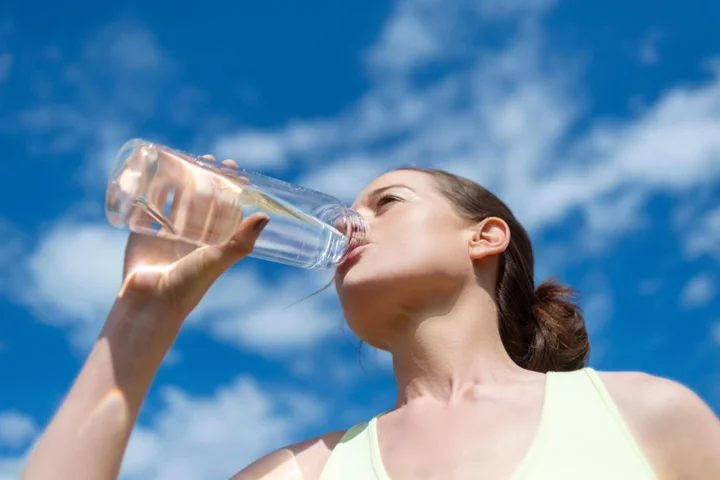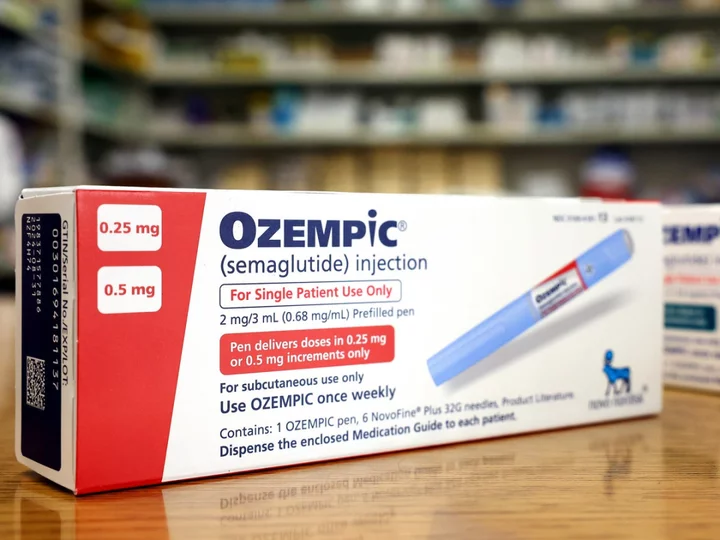
Jonnie Irwin makes rare red carpet appearance as he says ‘every day is a gift’
Jonnie Irwin has said that he “takes every day as a gift as it comes” amid his treatment for terminal cancer. The A Place in the Sun presenter, 49, made a rare red carpet appearance at the Television and Radio Industries Club (TRIC) Awards on Tuesday night (27 June) in London. Irwin also spoke about the support he has received from the BBC’s Escape To The Country production team and said they “put their arm around me” after he divulged his diagnosis. The TV host publicly revealed that he had been diagnosed with lung cancer that had spread to his brain in November 2022, after keeping it a secret among close friends and family for two years. He told The Mirror at the TRIC Awards: “Today is a good day. Yesterday I peeled myself out of bed and munched painkillers but so far so good today. I take every day as a gift and as it comes.” Irwin previously claimed that Channel 4 “pushed him aside for someone healthier” after discovering his terminal cancer diagnosis and told him they didn’t “think they can get the insurance”. He spoke of being “heartbroken” by the broadcaster, adding: “I just feel I’d earned a bit more from them after 18 years”. Channel 4 representatives said the production company “were unable to secure adequate insurance cover” for Irwin. However, Irwin had nothing but praise for Escape To The Country, which he described as “family” to him. “With a notable exception from one production company, as soon as they found out they put their arm around me and, insurance provided, they looked for work when I could,” he said. “So any location that was anywhere near me I was [the] first candidate for and they really helped me find work. They were understanding, especially with travel arrangements. They were so supportive, I can’t thank them enough.” Escape To The Country was nominated for the Daytime TV award at the event, alongside A Place in the Sun. The latter won the category at the end of the night. Prior to the winners being announced, Irwin described the production team as “family” and said the nomination was “recognition” for all their work. “I’ve worked on Escape for coming up to 10 years, but 20 years in the industry and I’ve had the most fun and it’s the most like a family of all the shows I’ve done,” he added. When he first revealed his diagnosis, Irwin said he “doesn’t know how long” he has left to live, but hopes he will inspire people to “make the most of every day”. Earlier this month, he celebrated his “best ever” Father’s Day with his three sons, four-and-a-half-year-old Rex and three-year-old twins Rafa and Cormac. He shares his children with wife Jessica Holmes. It came after he revealed in an interview with Hello! magazine ahead of Father’s Day that he has not told his sons about his terminal cancer, saying it would “be horrible news that they’d have to get their heads around”. “And it would confuse the hell out of Rex – he’s got a shocking enough day coming,” Irwin said. “Let’s bury our heads in the sand for as long as possible.” Read More Walk this way... but not like that: How men’s walks became sexualised Jennifer Lawrence addresses Liam Hemsworth affair rumours after Miley Cyrus’s ‘Flowers’ music video ‘I don’t deserve this’: Tom Hanks’ niece has screaming meltdown on Claim to Fame Jonnie Irwin celebrates ‘best Father’s Day ever’ amid terminal cancer diagnosis Jonnie Irwin ‘removes himself’ from family home amid terminal cancer battle Nicolas Cage once bought seat on plane for son’s imaginary friend, Minnie Driver says
2023-06-28 15:21

Hacks for saving money on school uniforms
Parents and carers of children in secondary school are still spending “exorbitant amounts” on school uniforms, a charity has said. According to research conducted by The Children’s Society, which surveyed 2,000 parents across the UK in May, on average they are spending £422 per year on uniforms and £287 for primary school children. The survey found that on average pupils were expected to have three branded items, with 29% of secondary school pupils expected to own up to five branded items including PE kits, and 13% expected to have at least seven. So how exactly can parents and carers save money on school uniforms? Buy secondhand Sometimes there’s a means to buy secondhand uniforms at the school through the Parent Teacher Association, Matthew Easter, chairman of The Schoolwear Association, says. But if this isn’t the case, he adds: “Parents should challenge schools and members of staff to provide better financial support to parents.” Parents can even ask the school to reach an agreement with their recommended retail partner, to help them save money. “Have a look on local Facebook sites or sometimes schools have secondhand sales themselves,” advises teacher, mother and money saving expert Sophie Bradbury. “Sometimes you can get uniform that’s barely been worn as someone’s grown out of it too quickly. If you know anyone with children in their older years, ask them. Chances are they’ve still got some old jumpers or polo shirts hanging around. “Also check out your local charity shops and make sure to ask if they have any uniform out the back. Charity shops don’t put everything out straight away, so it’s always worth an ask. [You can also try] car boot sales. I always see old uniforms going for pennies.” It’s great when siblings attend the same school too, because you can pass down their old items. Buy good quality uniform that lasts It’s tempting to buy cheap school uniforms, but for Easter suggests it’s better to focus on quality over quantity. Easter is a parent of two girls aged seven and 10, and understands the strain it can put on families. “School uniforms are unique pieces of clothing, because pupils wear it for at least 196 days every year. It hardly changes too and doesn’t get lost as much as parents think – it’s only a small proportion. So why not invest in quality branded clothing that will last your child for a few years? “It means you can focus on purchasing the quality staple branded items, including a blazer, jumper – depending on the school – and tie from recommended retailers and then get skirts, trousers, white shirts, shoes and anything else required from independent retailers or supermarkets on the high street.” In reality, Easter suggests parents end up spending more in a shorter space of time buying lower quality uniforms, because they might need to be replaced. Buy it big so you get more out of it Uniforms tend not to be a one-time cost: you’ll have to buy replacements whenever you child has a growth spurt and the garments no longer fit. An easy hack to minimising the amount of new uniforms you have to buy? Buy the items a bit too big, giving your child time to grow into it. Recycle or upcycle Clothing is one of the world’s most polluting industries, so don’t throw your uniform away. You can always donate them to organisations that upcycle and recycle school uniforms, such as the Re:Form scheme (run by Trutex), which sells pre-owned uniforms at reduced prices. Or organisations like Pickni Uniforms, founded by Croydon rapper Jords and his friend Jamahl Rowl, which collaborates with schools, community organisations, and social service agencies to provide free school uniforms to students from low economic backgrounds. Read More Charity boss speaks out over ‘traumatic’ encounter with royal aide Ukraine war’s heaviest fight rages in east - follow live King Charles and Queen Camilla surprise spa guests in bathrobes at eco-village Nearly 1.5m 18 and under referred for mental health support in 2022 – charity Holiday hygiene horrors: Summer health risks to avoid, from flying to hotels
2023-06-27 21:47

Holiday hygiene horrors: Summer health risks to avoid, from flying to hotels
Nobody likes getting sick, and illness on holiday is even worse – who wants to waste their precious vacation days lying in bed when they could be out having fun? Unfortunately, the chances of catching a bug can be high when you’re travelling. From airports and planes crammed with passengers to hotel rooms and restaurants with questionable cleanliness (even if it’s not visible to the naked eye), no wonder so many of us end up with the lurgy abroad. Here, health experts discuss the major health risks that occur on summer holidays and how to avoid them. Airports “Airports often become crowded and therefore they present multiple hygiene risks,” suggests Dr Donald Grant from The Independent Pharmacy. “Touching surfaces, using airport bathrooms and being in close proximity to others can cause bacteria to spread, so it’s important to be hygiene-alert.” Plus, having to hand your passport, boarding pass and luggage to different staff members increases the number of touchpoints throughout your journey. Dr Angela Rai, GP from the London General Practice recommends regularly washing your hands or applying hand sanitiser as you make your way through the airport. She says: “Washing your hands or using hand sanitiser helps reduce the risk of transmission of lots of different infections, including viral infections, coughs and colds and potentially gastrointestinal infections as well.” Flying “If someone is sitting next to you [on an airplane] and they have a cold, it may well be that you might catch one,” says Dr Preethi Daniel, deputy medical director at London Doctors Clinic. “There are hundreds of viruses that cause illness and the fact that you are mixing with people from all over the world means exposure to viruses and bugs your body may not be used to already.” It’s not only airborne bugs that you have to worry about, says Grant: “Again, it’s important to wash or sanitise your hands frequently during your flight, especially before eating or drinking, after using the bathroom, or if you’ve touched your armrest, tray table or TV screen.” As an extra precaution, you might also want to wipe down your down your table and armrests with an antibacterial wipe. Hotel rooms “While all hotel rooms should be thoroughly cleaned between each guest’s stay, you can never be fully sure that your room is bacteria-free,” says Grant. “To be on the safe side, take some disinfectant wipes and give the surfaces a good wipe down when you arrive — and don’t forget the TV remote, which may have been handled by hundreds of people without being cleaned.” Be extra careful with eating and drinking utensils in your room, he adds: “You should avoid using drinking glasses or mugs provided by the hotel without cleaning them thoroughly first.” Food and drink When eating and drinking at local spots abroad, Daniel’s advice is to “check for cleanliness even in established restaurants; paying particular attention to the state of tablecloths, cutlery, glasses and whether the tables are wiped down properly”. Look out for flies on food as well, she warns: “They are often loaded with pathogens as they do not discriminate between feeding on food or faeces. “E. coli, salmonella or shigella are some of the most common causes of gastrointestinal infections on holiday. “Hepatitis A and typhoid are other infections you can contract from contaminated food or water.” Never drink tap water unless you know it’s safe, and beware of tap water being used in food and drink prep. Rai says to be careful with ice as it might have been made with tap water and “things like salads and raw vegetables that have been washed in that water”. “Stick to peelable fruit,” Daniel adds. “Bananas, mangoes and the like are perfectly fine to eat. Avoid anything that has already been peeled, chopped and is waiting in handy takeaway sizes for you.” Swimwear and towels “Unpleasant odours and growth of bacteria are some of the risks of poor hygiene when it comes to swimwear and beach towels,” says Daniel. “They trap moisture”, which could leave you vulnerable to “getting infections such as bacterial vaginosis or thrush”. Grant says: “Be mindful that your towel is likely getting dirtier on holiday than it would be at home — especially if you’re taking it to the beach or the pool. You should change or wash your towel at least every other day.” And unless you’ve got a different swimsuit for every day of the holiday, you’ll need to give it a wash. “You’re meant to wash your swimwear after every time you wear it, because you have to treat it like your underwear,” says Rai. Haven’t got access to a washing machine on holiday? Rai says: “Just gently hand wash your swimwear every time you use it with warm soapy water then hang it up to dry.” Read More Charity boss speaks out over ‘traumatic’ encounter with royal aide Ukraine war’s heaviest fight rages in east - follow live Pretty garden plants you didn’t know you could eat Group B Strep: 8 things every parent should know Princess Diana’s ‘black sheep’ jumper predicted to sell at auction for up to £70,000
2023-06-27 16:49

Kourtney Kardashian and Travis Barker reveal the gender of their baby
Kourtney Kardashian and Travis Barker have revealed the gender of their new baby. Earlier this month, Kardashian, 44, announced that she and Barker are expecting their first child together. On Saturday 24 June, the couple – who tied the knot last May – posted a gender reveal video on Instagram, along with a caption of pink and blue hearts. Kardashian is seen sitting on Barker’s lap, alongside a drum kit on a stage. The Blink-182 drummer can be heard saying: “Is our pyro guy ready?” The Poosh founder replies: “I don’t know what’s happening, whatever you guys had planned…” Her sister Khloe Kardashian can apparently be heard saying: “Let’s get the party started – we’re all excited!” Barker, 47, then begins a drum roll which ends with a burst of blue streamers, as the couple’s family and friends celebrate the news that they’re having a baby boy. “I love how they dont even look at anyone else when they’re together,” one fan reacted to the video. Referencing Kardashian and Barker’s couple name, another wrote: “They can actually name [the baby] Kravis.” Kardashian first shared the news she and Barker, 47, are expecting with a Blink-182-style pregnancy reveal video. In it, the mother of three can be seen holding up a sign that reads “Travis I’m pregnant”, recreating a scene from one of the band’s hit songs “All the Small Things”. While the video was widely celebrated on Instagram, some people suggested it was “staged” since Kardashian’s baby bump was apparently visible in it. Fans defended the reality star at the time, claiming it didn’t matter when Barker found out, and that the point of the video was simply to share the news with their followers. Earlier this week, Kardashian shared pictures of her growing baby bump, as some users speculated about her due date. Kardashian and Barker tied the knot after years of being friends, and celebrated their marriage with three wedding ceremonies – including one officiated by an Elvis impersonator in Las Vegas. Since then, the couple has documented parts of Kardashian’s experience with fertility treatments on her family’s reality series The Kardashians. In an episode last April, she also addressed how “every single person on social media is always like, ‘Kourtney’s pregnant, Kourtney’s pregnant, Kourtney’s gained so much weight” while she was undergoing IVF treatments. She told her mother Kris Jenner: “I’m like, it’s so rude to comment on people when you have no idea what they’re actually going through.” At the time, she also explained how the medication “basically put me into a depression”. Kardashian shares three children with her former partner Scott Disick. Meanwhile, Barker shares two children with his ex-wife and former Miss USA, Shanna Moakler. Read More Mother shares heartbreak after inviting whole school class to daughter’s birthday party Lewis Capaldi opens up about worsening Tourette’s tics while he’s on stage Gongs, chanting and Celtic Shamanism: What I learnt from a day at the Glastonbury Healing Field Prince Harry ‘wanted to interview Vladimir Putin and Donald Trump about childhood trauma’ How Center Parcs became a symbol of class
2023-06-25 19:29

GymBird Is Hiring a “Chief Step Officer” to Walk 10,000 Steps for $10,000
Walking 10,000 steps a day can be tough to find the time or motivation for—but you’d probably do it for $10,000.
2023-06-23 21:27

What happens if you don’t wash your water bottle often enough?
Reusable water bottles are beneficial in so many ways. Helping keep you hydrated, they also cut down on single-use plastic, and save you money every time you refill instead of buying a new bottle of water. Plus, with all the chic stainless steel flasks and glass bottles on the market – not to mention sporty carrying straps – they’ve become something of a fashion accessory. Trying to hit the NHS-recommended eight glasses of water a day for adults is an excellent idea, of course, but did you know there’s one way your refillable bottle could potentially be detrimental to your health? According to a study from waterfilterguru.com, reusable water bottles contain an average of 20.8m colony-forming units (CFUs) of bacteria, which equates to 40,000 times more than the microbes on a toilet seat. So what might be the consequences if you continuously sip and refill without washing your bottle properly between uses? We asked health experts to talk through the risks… Bottling up bacteria “A common misconception when it comes to reusable water bottle hygiene is that as you’re typically filling it with pure water and it’s only coming into contact with your own mouth, there’s little need to clean it often,” says Dr Donald Grant, senior clinician at The Independent Pharmacy. However, every time you drink from the bottle, you’re transferring bacteria from your mouth, which can then multiply in the container. “Anything that is reusable can be prone to accumulating dirt, dust or debris and, as a result, bacteria,” says private GP Dr Suhail Hussain. “This is exacerbated by the fact water bottles are the ideal environment for harbouring bacteria due to being moist.” Hard to reach crevices – for example, inside a screw top or under a flip-up straw – could also develop mould, and then there’s contamination from other sources. “When you store it in a gym bag, for instance, it can pick up bacteria from the interior of the bag or anything else stored in it, while you can also transfer bacteria from your hands to your bottle,” says Grant. “If your bottle has a valve cap, you may need to lift or twist it with your fingers, and this can transfer bacteria you may have picked up from touching other objects or surfaces.” What types of microbes are found in water bottles? “These might be simple commensals such as streptococcus and staphylococcus, which normally live in symbiosis with their host (i.e. us) but can become problematic if they accumulate, or the individual is under the weather,” Hussain says.“Bacteria such as E. coli – a common cause of urine and bowel infections – can often colonise the water bottle following repeated handling, such as taking the cap on and off.” These bacteria can potentially cause a variety of issues. “You may become sick and develop gastric illness, such as diarrhoea or vomiting,” Hussain continues. “Gram negative rods – another common bacterium found in unwashed bottles – can lead to urogenital tract infections and pneumonia.” Grant warns: “If there’s a build-up of mould inside the bottle, this can cause allergy symptoms, such as a runny nose, sneezing, or red and itchy eyes. Symptoms might be more severe for someone with asthma.” How often should you wash your reusable water bottle? “To minimise your risk of getting sick, you should ideally clean your water bottle after each use,” Grant says. “As a minimum, you should aim to wash it thoroughly at least a few times a week.” Hot water and washing up liquid are all you need to banish bacteria on the daily. “Fill the bottle with hot soapy mixture and swill around, or leave to soak in a detergent mixture,” Hussain advises. “Remember to pay special attention to lids/caps and screw top regions – use a clean brush [to scrub them].” If you’ve neglected your bottle for a few days and it needs a deeper clean, Grant suggests: “Soak your bottle overnight in a solution of half vinegar and half water. Rinse the bottle and let it dry fully before using it again.” Storage is also important to help minimise nasty microbes. “Where possible, you should keep your water bottle out of germ-rich environments such as your gym locker or sports bag,” Grant says. “You should also avoid filling your bottle with anything other than water, such as protein shakes, energy drinks, or sugar-rich liquids, as sugar can stimulate the growth of bacteria.” Hussain adds: “Don’t leave water bottle in the sun for long periods of time or siting in the cup holder in the car – the mixture of warmth and moisture is likely to make bacterial overgrowth worse.” Read More Charity boss speaks out over ‘traumatic’ encounter with royal aide Ukraine war’s heaviest fight rages in east - follow live Prince George visits Eton with parents Prince William and Kate Middleton King Charles and Queen Camilla ecstatic after getting their first Royal Ascot winner As Elon Musk calls cis ‘a slur’ – what does the term cisgender actually mean?
2023-06-23 15:18

Gambia tightens rules for Indian drugs after cough syrup deaths - letter
By Krishna N. Das and Edward McAllister NEW DELHI (Reuters) -Gambia will make it mandatory for all pharmaceutical products from
2023-06-21 10:18

6 hacks for handling the heatwave at a festival
With the heatwave stretching on this summer, festival-goers may be worried about handling the hot temperatures. The medical team at the Isle of Wight Festival said they saw fewer heat-related issues than expected, but there has still been a 15% rise in incidents since last year. With Glastonbury temperatures predicted to fall between 21 and 25 degrees, how can you make sure you stay safe? 1. Find shade – anywhere on the site When you see photos and videos of festival sites, it can look pretty exposed to the elements. “At festivals, seek shade in festival tents or near stages, or by going to bars… Even take a gazebo to go with your tent [if the festival allows],” says associate medical director of St John Ambulance, David Monk. When out in the field, take an umbrella or parasol if you are worried, Monk explains. And also, consider “wearing light layers and a cap”, he says. “Perhaps take a wet cloth to pop on the back of your neck, or wet the cap and wear it to cool you.” 2. Put sun cream everywhere “Make sure you wear a good head covering, at least SPF 30, and reapply regularly, so take it into the festival with you. When you get sweaty, it will need reapplying,” Monk explains. If you are dressing up in wild clothing, “apply sun cream before putting it on and reapply it, and make sure you take something to wear when it starts getting cooler”, he explains. “Put sun cream under make-up and glitter, and look at a sun cream spray for your scalp” – especially important if you don’t want to wear a hat. 3. Know what to look out for Knowing the signs of heatstroke and severe burns is vital. The main risks are sunburn, heatstroke and heat exhaustion. “Heat exhaustion is something you can self-treat by drinking lots of water or weak squash, and eating salty foods. If you think you have heatstroke, however, seek help from the medical teams,” Monk says. Signs include not sweating despite being hot, and a reduced level of consciousness, he adds. “If you get burnt, think how bad it is. If it blisters, you feel unwell or are shivering, seek help from the festival medical teams.” They should be fairly easy to find and signposted – ask around if you can’t see any. However, if it is less severe, just do lots of moisturising and rehydrating, he suggests. 4. Drink water and know how hydrated you are “Drink alcohol in moderation, and drink water alongside it. When you go to the loo, check how dark your urine is,” Monk suggests. This isn’t always possible in festival toilets, but you might detect darker and more dehydrated urine from its smell. 5. Pack the electrolytes When you sweat, you lose a lot of electrolytes, like salt. “Take an electrolyte drink with you – things like sports drinks, or Dioralyte, to replace whatever you lose,” says Monk. “Make sure you’re eating things with salt in, and carbohydrates, to give you energy.” 6. Keep an eye on drink and drugs “If people are going to take drugs, make sure those around you know what you have taken, in case they need to tell someone if there is a problem. Drugs and alcohol reduce your body’s ability to respond to the heat,” says Monk. Read More Charity boss speaks out over ‘traumatic’ encounter with royal aide Ukraine war’s heaviest fight rages in east - follow live Regular daytime naps could be good for the brain, study shows Meghan ‘set to sign’ Dior deal: 4 times she’s worn the brand Designer JW Anderson wears Irish rugby top on the runway
2023-06-20 14:45

Scientist behind Ozempic says drug can make life ‘so miserably boring’
One of the scientists whose work pioneered the development of medications such as Ozempic and Wegovy has revealed why life may become “so miserably boring” after two years of using the drug. Ozempic is an FDA-approved medication used for the treatment of type 2 diabetes. It works by mimicking a hormone called glucagon-like peptide 1 (GLP-1), which regulates blood sugar levels and slows down the rate at which food leaves the stomach, often creating the feeling of fullness. These semaglutide injections – sold under the brand names Ozempic and Wegovy – have soared in popularity as many people, including Hollywood celebrities, have used it for weight loss. What’s more, people have also found Ozempic has been effective in curing their addictive habits, like drinking, smoking, shopping, or nail biting. However, because of Ozempic’s increasing popularity, it has led to national shortages of the type 2 diabetes treatment – leaving those who actually need it without. In an interview with Wired, professor Jens Juul Holst – who received the Warren Alpert Foundation Prize in 2021 for his work developing treatments based on the GLP-1 hormone – spoke about the effects of Ozempic, and why he believes many people will stop taking the medication after just a few years. “What happens is that you lose your appetite and also the pleasure of eating, and so I think there’s a price to be paid when you do that,” Holst told Wired. “If you like food, then that pleasure is gone. The craving for food for some people is taken away when they take GLP-1 drugs.” He continued: “That may eventually be a problem, that once you’ve been on this for a year or two, life is so miserably boring that you can’t stand it any longer and you have to go back to your old life.” Holst added that medications like Ozempic and Wegovy have been on the market since 2005, though studies show that these people don’t stay on them for very long. “It’s just like every other drug, they don’t stay on it for many reasons,” he explained. “One of the reasons, as I said, is that once you have tried it and you realise you’ve lost interest in food, then that may be enough.” “We don’t know why people stop taking these drugs, but we know for a fact that they do stop. They do that all over the world.” A 2020 study found that 70 per cent of people who took GLP-1 drugs for type 2 diabetes stopped taking them within two years. However, this could pose a problem for many patients taking semaglutide injections. Research has found that people who stopped taking Ozempic or Wegovy for weight loss experienced weight rebound. A trial published in April 2022 saw participants gain back two thirds of the weight they had lost after 68 weeks of taking semaglutide. As for celebrities who use the once-weekly injection for weight loss, despite not having diabetes or clinical obesity, Hans instead called attention to the “many terrible problems” that those with diabetes have struggled with by not having drugs like Ozempic readily available. “Have you ever visited a diabetes hospital? It’s really deplorable,” he said. “People come in with amputated limbs and compromised cognitive functions and heart problems or they can barely move – they’re miserable and depressed. It’s really serious. There is so much you can improve with a drug that is not only a weight-loss drug but is also an anti-diabetic.” Amidst the popularity of semaglutide injections, the US Food and Drug Administration has issued warnings for consumers not to use off-brand versions of Ozempic or Wegovy, because they may not include the same GLP-1 hormone used in approved medications. Earlier this month, agency officials reported problems with patients using compounded versions of semaglutide – which combines traditional semaglutide with other ingredients. These drugs are not FDA-approved, and the agency does not verify the safety or effectiveness of compounded drugs. Consumers should only use drugs containing semaglutide with a prescription from a licensed health care provider and obtained from a state-licensed pharmacy or other facilities registered with the FDA, the agency said. Read More What is ‘Ozempic face’? Doctors warn about facial ageing side effect of diabetes medications How does Wegovy work? The ‘game changing’ weight loss drug beloved by Hollywood FDA warns against using off-brand versions of Ozempic, Wegovy for weight loss Pregnant Stassi Schroeder admits she wants to ‘try’ Ozempic after giving birth Doctors warn about ‘Ozempic face’ side effect of medications Amy Schumer says she stopped taking Ozempic because of side-effects
2023-06-16 23:52

Why do we get so tired in hot weather?
Does very hot weather leave you feeling more exhausted and lethargic than usual? There might be an initial surge of joy when the sun finally comes out – but once temperatures really creep up, we can end up feeling physically drained, wondering whether we should follow the Mediterranean’s lead and start introducing daily siestas. So, why does hot weather make us so tired? We asked a doctor to explain… Our bodies have to work harder in the heat “When the weather is hot, our bodies have to work harder to cool themselves down,” says Dr Zulqarnain Shah, medical director at SSP Health and GP at SSP Health practice Colne Road Surgery. “The body’s natural cooling mechanism involves increasing blood circulation near the skin’s surface and promoting sweat production. These physiological changes can lead to fatigue and a feeling of lethargy. It is essential to recognise that this fatigue is a normal response to heat and is typically temporary.” Dehydration Low energy and tiredness are also common when you’re lacking hydration. “Hot weather increases the rate of fluid loss through sweating, leading to dehydration. Dehydration can contribute to fatigue and make you feel even more lethargic,” adds Dr Shah. “To avoid this, it’s important to stay adequately hydrated by drinking plenty of fluids, especially water. Aim to drink even when you’re not feeling thirsty, as thirst is not always an accurate indicator of dehydration.” Heat exhaustion “Prolonged exposure to heat can result in heat exhaustion, a condition characterised by symptoms such as heavy sweating, weakness, dizziness, nausea, headache, and muscle cramps. If you experience these warning signs, it’s crucial to move to a cooler environment, drink fluids, and rest. If symptoms persist or worsen, seek medical attention promptly,” says Shah. It’s important to pay attention to warning signs, as if heat stroke develops, this is a medical emergency. Shah stresses: “Heat stroke is a severe and potentially life-threatening condition that requires immediate medical intervention. It occurs when the body’s temperature regulation fails, and the core temperature rises dangerously high. “Symptoms may include a high body temperature (above 39.4C), altered mental state, confusion, rapid breathing, rapid heartbeat, and even loss of consciousness. If you suspect heat stroke, call emergency services immediately.” Sleep deprivation The extra tiredness could also be linked to poor sleep, as this can really suffer in the heat. “Hot temperatures can disrupt sleep and lead to poor sleep quality. The body needs to cool down to initiate sleep, and the excessive heat can make it difficult to reach the optimal sleep temperature,” explains Shah. “To improve sleep in hot weather, consider using fans or air conditioning, wearing lightweight and breathable sleepwear, keeping your bedroom well-ventilated, and using lighter bedding.” Pre-existing conditions could get worse Many people living with chronic or long-term health conditions deal with fatigue, which may flare up during heatwaves. “Hot weather can exacerbate symptoms and increase fatigue in individuals with certain chronic health conditions. Conditions such as heart disease, kidney problems, and respiratory issues can be particularly sensitive to heat,” notes Shah. “It’s vital to be aware of your specific health condition and consult with your healthcare provider for personalised advice on managing your symptoms during hot weather. They may recommend staying in cooler environments, adjusting medications, or monitoring your fluid intake more closely.” Read More Airbnb customer furious after being charged extra over dog hair People seek hay fever advice once every three seconds, says NHS England Why is my hay fever so bad at the moment?
2023-06-16 20:18

Why am I so lethargic in the heat?
Does very hot weather leave you feeling more exhausted and lethargic than usual? There might be an initial surge of joy when the sun finally comes out – but once temperatures really creep up, we can end up feeling physically drained, wondering whether we should follow the Mediterranean’s lead and start introducing daily siestas. So, why does hot weather make us so tired? We asked a doctor to explain… Bodies have to work harder in the heat“When the weather is hot, our bodies have to work harder to cool themselves down,” says Dr Zulqarnain Shah, medical director at SSP Health and GP at SSP Health practice Colne Road Surgery. “The body’s natural cooling mechanism involves increasing blood circulation near the skin’s surface and promoting sweat production. These physiological changes can lead to fatigue and a feeling of lethargy. It is essential to recognise that this fatigue is a normal response to heat and is typically temporary.” Dehydration Low energy and tiredness are also common when you’re lacking hydration. “Hot weather increases the rate of fluid loss through sweating, leading to dehydration. Dehydration can contribute to fatigue and make you feel even more lethargic,” adds Dr Shah. “To avoid this, it’s important to stay adequately hydrated by drinking plenty of fluids, especially water. Aim to drink even when you’re not feeling thirsty, as thirst is not always an accurate indicator of dehydration.” Heat exhaustion “Prolonged exposure to heat can result in heat exhaustion, a condition characterised by symptoms such as heavy sweating, weakness, dizziness, nausea, headache, and muscle cramps. If you experience these warning signs, it’s crucial to move to a cooler environment, drink fluids, and rest. If symptoms persist or worsen, seek medical attention promptly,” says Shah. It’s important to pay attention to warning signs, as if heat stroke develops, this is a medical emergency. Shah stresses: “Heat stroke is a severe and potentially life-threatening condition that requires immediate medical intervention. It occurs when the body’s temperature regulation fails, and the core temperature rises dangerously high. “Symptoms may include a high body temperature (above 39.4°C), altered mental state, confusion, rapid breathing, rapid heartbeat, and even loss of consciousness. If you suspect heat stroke, call emergency services immediately.” Sleep deprivation The extra tiredness could also be linked to poor sleep, as this can really suffer in the heat. “Hot temperatures can disrupt sleep and lead to poor sleep quality. The body needs to cool down to initiate sleep, and excessive heat can make it difficult to reach the optimal sleep temperature,” explains Shah. “To improve sleep in hot weather, consider using fans or air conditioning, wearing lightweight and breathable sleepwear, keeping your bedroom well-ventilated, and using lighter bedding.” Pre-existing conditions could get worse Many people living with chronic or long-term health conditions deal with fatigue – which may flare up during heatwaves. “Hot weather can exacerbate symptoms and increase fatigue in individuals with certain chronic health conditions. Conditions such as heart disease, kidney problems, and respiratory issues can be particularly sensitive to heat,” notes Shah. “It’s vital to be aware of your specific health condition and consult with your healthcare provider for personalised advice on managing your symptoms during hot weather. They may recommend staying in cooler environments, adjusting medications, or monitoring your fluid intake more closely.” Read More Charity boss speaks out over ‘traumatic’ encounter with royal aide Ukraine war’s heaviest fight rages in east - follow live 8 tips for surviving Glastonbury with kids David Beckham designs new car collection with Maserati The dos and don’ts of looking after your garden in a heatwave
2023-06-16 15:55

Costco and Walmart Frozen Strawberries Are Subject to Recall—Here’s How to Check If Yours Are Affected
Everything you need to know about the frozen strawberries recalled from Costco, Walmart, and more stores.
2023-06-16 03:26
